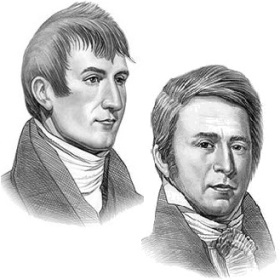|
With this
last nation ends the language of the Killamucks: and the coast,
which then turns towards the southwest, is occupied by nations
whose languages vary from that of the Killamucks, and from each
other. Of these, the first in order are,
The Cookoooose, a large nation of one thousand five hundred
souls, inhabiting the shore of the Pacific and the neighboring
mountains. We have seen several of this nation who were taken
prisoners by the Clatsops and Killamucks. Their complexion was
much fairer than that of the Indians near the mouth of the Columbia,
and their heads were not flattened. Next to these are,
The Shalalahs, of whom we know nothing, except their numbers,
which are computed at twelve hundred souls. Then follow,
The Luckasos, of about the same number, and
The Hannakalals, whom we estimate at six hundred souls.
This is the extent of the Indian information, and judging, as
we can do, with considerable accuracy from the number of sleeps,
or days journey, the distance which these tribes occupy along
the coast, may be estimated at three hundred and sixty miles.
On the north of the Columbia, we have already seen the Chinnooks,
of four hundred souls, along the shores of Haley's bay, and
the low grounds on Chinnook river. Their nearest neighbors to
the northeast are
The Killaxthokle, a small nation on the coast, of not more than
eight houses, and a hundred souls. To these succeed
The Chilts, who reside above Point Lewis, and who are estimated
at seven hundred souls, and thirty-eight houses. Of this nation,
we saw, transiently, a few among the Chinnooks, from whom they
did not appear to differ. Beyond the Chilts we have seen none
of the northwest Indians, and all that we learnt, consisted
of an enumeration of their names and numbers. The nations next
to the Chilts, are
The Clamoitomish, of twelve houses, and two hundred and sixty
souls.
The Potoashees, of ten houses, and two hundred souls.
The Pailsk, of ten houses, and two hundred souls.
The Quinults, of sixty houses, and one thousand souls.
The Chillates, of eight houses, and one hundred and fifty souls.
The Calasthorte, of ten houses, and two hundred souls.
The Quinnechant, consisting of two thousand souls.
A particular detail of the characters, manners, and habits of
the tribes, must be left to some future adventurers, who may
have more leisure and a better opportunity than we had to accomplish
this object. Those who first visit the ground, can only be expected
to furnish sketches rude and imperfect.
January 15, 1806
Wednesday, 15. Two hunting parties intended setting out
this morning, but they were prevented by incessant rain, which
confined us all to the fort.
The Chinnooks, Clatsops, and most of the adjoining nations dispose
of the dead in canoes. For this purpose a scaffold is erected,
by fixing perpendicularly in the ground four long pieces of
split timber. These are placed two by two just wide enough apart
to admit the canoe, and sufficiently long to support its two
extremities. The boards are connected by a bar of wood run through
them at the height of six feet, on which is placed a small canoe
containing the body of the deceased, carefully wrapped in a
robe of dressed skins, with a paddle, and some articles belonging
to the deceased, by his side. Over this canoe is placed one
of a larger size, reversed, with its gunwale resting on the
crossbars, so as to cover the body completely. One or more large
mats of rushes or flags are then rolled round the canoes, and
the whole secured by cords usually made of the bark of the white
cedar. On these crossbars are hung different articles of clothing,
or culinary utensils. The method practised by the Killamucks
differs somewhat from this; the body being deposited in an oblong
box, of plank, which, with the paddle, and other articles, is
placed in a canoe, resting on the ground. With the religious
opinions of these people we are but little acquainted, since
we understand their language too imperfectly to converse on
a subject so abstract; but it is obvious, from the different
deposits which they place by their dead, that they believe in
a future state of existence.
Next Journal
Entry
|

